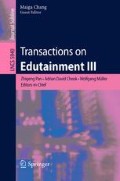Abstract
Undergraduate computing courses now cover aspects of computing ranging from the more formal computer science and software engineering, through traditional computer studies and information systems to multimedia courses and more recently specialist areas such as computer games, computer animation and computer forensics. In this paper we examine the potential use of animation for supporting teaching on the range of computing courses currently available within UK higher education. Experiments were conducted with groups of UK undergraduate computing students to compare the perceived usefulness of animated and static learning materials for teaching computing concepts such as diagrammatical design techniques, computer games development techniques and the mathematical techniques underpinning multimedia development. Overall animated learning materials appeared to be perceived as being more useful to undergraduate computing students than traditional static learning materials for learning such concepts.
Access this chapter
Tax calculation will be finalised at checkout
Purchases are for personal use only
Preview
Unable to display preview. Download preview PDF.
References
Schaefer, S., Warren, J.: Teaching computer game design and construction. Computer Aided Design 36(14), 1501–1510 (2004)
Callan, R.: Mathematics for computing. Letts Educational, London (1998)
Lengyel, E.: Mathematics for 3D game programming and computer graphics. Charles River Media, Hingham (2002)
Mustoe, L., Barry, M.: Mathematics in Engineering and Science. John Wiley and Sons, Chichester (1998)
Davies, G., Hicks, G.: Mathematics for scientific and technical students. Longman, Harlow (1998)
CCTA: SSADM 4+ Reference Manual, CCTA. NCC Blackwell, Oxford (1995)
Flash: Flash animation tool, Adobe Systems Incorporated (2008), http://www.adobe.com/products/flash
Mohler, J.: Flash MX: graphics, animation and interactivity. Delmar Learning, Clifton Park (2002)
Brisbourne, M., Chin, S., Melnyk, E., Begg, D.: Using web-based animations to teach histology. The Anatomical Record 269, 11–19 (2002)
Taylor, M.J., Pountney, D., Malabar, I.: Animation as an aid for the teaching of mathematical concepts. Journal of Further and Higher Education 31(3), 249–261 (2007)
Taylor, M.J., Duffy, S., Hughes, G.: The use of animation in higher education to support students with dyslexia. Education and Training 49(1), 25–35 (2007)
Taylor, M.J., Pountney, D., Baskett, M.: Using animation to support the teaching of computer game development techniques. Computers and Education 50(4), 1258–1268 (2008)
Tversky, B., Morrison, J., Betrancourt, M.: Animation: Can it facilitate? International Journal of Human-Computer Studies 57, 247–262 (2002)
Byrne, M., Catrambone, R., Stasko, T.: Evaluating animations as student aids in learning computer algorithms. Computers and Education 33, 253–278 (1999)
Khalil, M., Johnson, T., Lamar, C.: Comparison of computer based and paper based imagery strategies in learning anatomy. Clinical Anatomy 18, 457–464 (2005)
Stoffa, V.: Modelling and simulation as a recognizing method in education. Educational Media International 41(1), 51–58 (2004)
McGrath, M., Brown, J.: Visual learning for science and engineering. IEEE Computer Graphics and Applications 25(5), 56–63 (2005)
Mayer, R.: The promise of multimedia learning: using the same instructional design methods across different media. Learning and Instruction 13(2), 125–139 (2003)
Michas, I., Berry, D.: Learning a procedural task: effectiveness of multimedia presentations. Applied Cognitive Psychology 14, 555–575 (2000)
Park, O., Gittelman, S.: Dynamic characteristics of mental models and dynamic visual displays. Instructional Science 23, 303–320 (1995)
Philpot, T., Hall, R., Hubing, N., Flori, R., Oglesby, D., Vikas, Y.: Animated instructional media for stress transformations in a mechanics of materials course. Computer Applications in Engineering 11(1), 40–52 (2003)
James-Gordon, Y., Bal, J.: Learning style preferences of engineers in automotive design. Journal of Workplace Learning 13(6), 239–245 (2001)
Mathewson, J.: Visual-Spatial thinking: An aspect of science overlooked by educators. Science Education 83(1), 33–54 (1999)
Guimaraes, L., Barbastefano, R., Belfort, E.: Tools for teaching mathematics: A case for Java and VRML. Computer Applications in Engineering Education 8(3), 157–161 (2000)
Mayer, R.: Multimedia learning: are we asking the right questions? Educational Psychologist 32(1), 1–19 (1997)
Paivio, A.: Mental representations: a dual coding approach. Oxford University Press, New York (1990)
Leishman, D.: Visual literacy and learning: finding some online territories for the slow learner. On the Horizon 12(1), 26–30 (2004)
Albalooshi, F., Alkhalifa, E.: Multimedia as a cognitive tool. Educational Technology and Society 5(4), 49–55 (2002)
Koschke, R.: Software visualization in software maintenance, reverse engineering, and re-engineering: a research survey. Journal of Software Maintenance and Evolution: Research and Practice 15, 87–109 (2003)
Mayer, R., Moreno, R.: Animation as an aid to multimedia learning. Educational Psychology Review 14(1), 87–99 (2002)
Lowe, R.: Extracting information from an animation during complex visual learning. European Journal of Psychology in Education 14, 225–244 (1999)
Tall, D.: Intuition and rigour: the role of visualization in mathematics In: Zimmerman, W., Cunningham, S. (eds.) Mathematical Association of America Notes, vol. 19, pp. 105–119 (1991)
Faraday, P., Sutcliffe, A.: Designing effective multimedia presentations. In: Proceedings of the ACM SIGCHI 1997 Conference on Human Factors in Computing Systems, pp. 272–278 (1997)
Rieber, L.: Animation in computer-based instruction. Educational technology research and development 38, 77–87 (1990)
Passerini, K., Granger, M.: Integration of instructional approaches through media combination in an undergraduate information systems course. Campus-Wide Information Systems 16(5), 162–170 (1999)
Large, A., Beheshti, J., Breuleux, A., Renaud, A.: Multimedia and comprehension: The relationship among text, animation and captions. Journal of the American Society for Information 46(5), 340–347 (1995)
Blackboard: Blackboard Academic Suite, Blackboard Inc., Washington, DC, USA (2008), http://www.blackboard.com
LaMothe, A.: Tricks of the Windows game programming gurus. Sams Publishing, Indianapolis (2002)
Author information
Authors and Affiliations
Editor information
Editors and Affiliations
Rights and permissions
Copyright information
© 2009 Springer-Verlag Berlin Heidelberg
About this chapter
Cite this chapter
Taylor, M., Pountney, D. (2009). Animation as an Aid for Higher Education Computing Teaching. In: Pan, Z., Cheok, A.D., Müller, W., Chang, M. (eds) Transactions on Edutainment III. Lecture Notes in Computer Science, vol 5940. Springer, Berlin, Heidelberg. https://doi.org/10.1007/978-3-642-11245-4_18
Download citation
DOI: https://doi.org/10.1007/978-3-642-11245-4_18
Publisher Name: Springer, Berlin, Heidelberg
Print ISBN: 978-3-642-11244-7
Online ISBN: 978-3-642-11245-4
eBook Packages: Computer ScienceComputer Science (R0)

